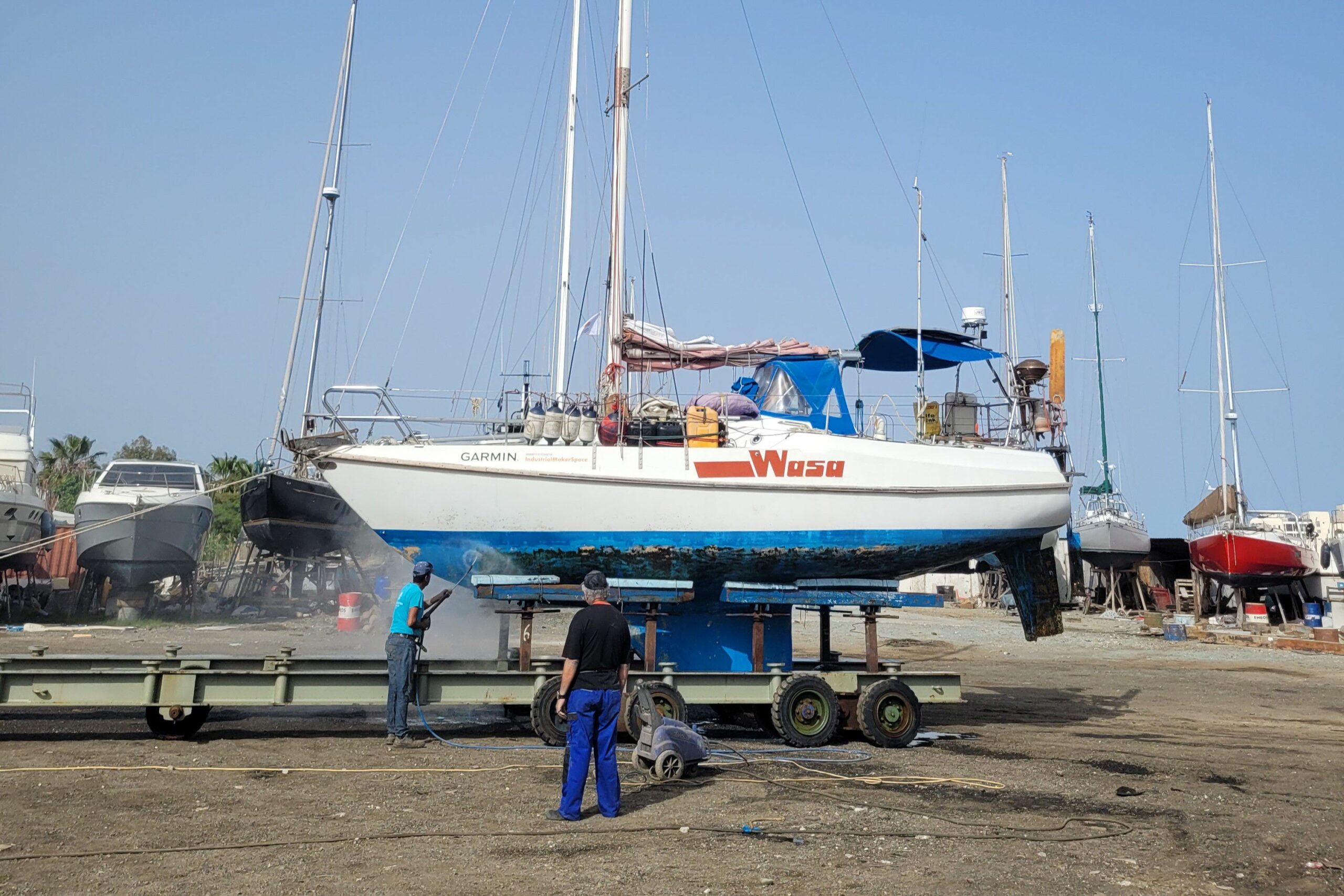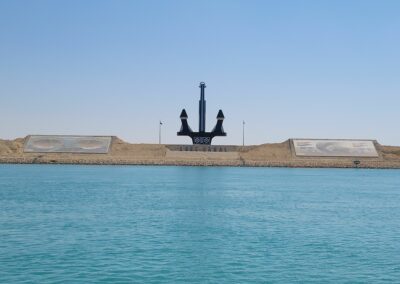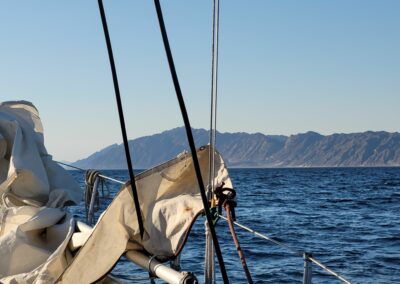
„Returning to Europe“ – for months that has been the voice in my head, giving me motivation and power to keep on sailing.
When I was sent back out to sea with my repaired mast, I was pretty excited! As soon as I had left the sheltered bay, the wind hit me much harder than predicted, of course. As usual, also the waves were coming at me steep and at short intervals.
With narrowed eyes, I tried to look against the glaring sunlight and assess the movements in the mast. I also constantly checked the markings on my improvised rigging parts.

To put as little strain as possible on the material but still make progress, I chose a small sail setup (main in 2nd reef & strong wind jib on second forestay) and additionally kept the engine running. That’s how I tacked my way up towards Suez. I had to be even more careful and follow the weather forecast: Under no circumstances did I want to get caught in another storm!
Only now that I have recovered have I realized how tired and exhausted I was back then!
The endless miles in the Gulf of Aden, sleepless nights between air raids and fishing boats in Bab el Mandeb, followed by storms, mast breakage and five days of repairs in the military port in Egypt had really used up my energy!
I was annoyed by them at the time, but the various forced stops I had to make on the way to Suez gave me the breather I needed: about every 50 nautical miles, there was an anchorage where I was allowed to seek shelter from the strong northerly winds. Cruising on a zigzag course though, I regularly needed well over 24 hours to cover the actually ridiculous distances!
In these bays, anchoring was allowed, and the protection from wind and waves was usually very good, but going ashore was NOT an option under ANY circumstances! I wasn’t even allowed to leave the dinghy in the water. I couldn’t go shopping or get diesel. This had to be done secretly with the help from some fishermen.


The last stretch of the Red Sea, the Gulf of Suez, was particularly challenging: over a length of more than 100 nautical miles, the Gulf is no wider than 20 nautical miles. The wind regularly accelerates to 30 knots or more between the steep coasts and the water is scattered with oil fields and drilling rigs. In El Tur, a village at the foot of Mount Sinai (where according to the Bible Moses received his 10 commandments), I lay at anchor for seven days and waited before the wind calmed down briefly.
Every single mile was a fight! The days were hot, the nights freezing cold! But eventually – around three o’clock in the morning – I reached my assigned anchorage off the Suez Canal! (chart)
The Suez Canal was opened in 1869 (45 years before the Panama Canal) and connects the Red Sea with the Mediterranean over around 80 nautical miles. Unlike its brother in Panama, there are no locks in the Suez Canal. That’s why I didn’t need any other linehandlers on board to help me. Only a pilot was mandatory here, too. He knows all the special features of the canal, gives instructions and keeps in touch with the control stations en route.

I was in contact with my agent, who organized the transit for me, during the whole approach through the red sea. That’s why my transit already started early the next morning, even though I had arrived so late at night. The pilot came on board: „Anchor up and full speed ahead!“. It was just under 50 miles to the stopover in Ismalia and we hoped to arrive before sunset.
I sent another prayer towards the engine compartment, then we cast off. I have had heard many stories about the Suez Canal beforehand: „Strong currents that make life difficult and canal pilots who only do a conscientious job after receiving a baksheesh (tip/bribe).
The current is determined by the tides. In my case, it was up to 2.5 knots against me for the first two hours, but then turned and we rushed north at an average speed of 5 knots.
I also had no problem at all with my pilots! Bakschisch was banned the previous year and I had the feeling that the pilot was trying to bribe me as often as he wanted to offer me one of his cigarettes or sweets.
We didn’t quite reach the marina in Ismalia in time. It had already been dark for two hours when I tied and my pilot could hardly wait to jump off the boat. The harbor is a special zone, similar to the transit area at airports, and we weren’t allowed to leave it just like that.
Bill & Xixi from SY CAJUCITO and Uli, Barbara and John from SY ISLANDER, as well as three other yachts I knew briefly, were also there! More than two months ago we had left from the Maldives together and now, at the end of an incredible odyssey, on which everyone had experienced their very own story, we met again at the gateway to the Mediterranean!

Groceries and food had to be delivered and „leaving“ to visit the sights of Egypt would only have been possible with a lot of paperwork, agents, a rental car and in the company of the security service. For five days, my friends and I waited here in our „five-star prison“ for a suitable weather window to tackle the second part of the canal and the final leg to Cyprus.
Another three days at sea, then the outline of Cyprus appeared at dawn! Never has land smelled – damp, like earth – and looked so good and never have I looked forward to a walk, a beer and dancing as much as this time!
FINALLY BACK IN EUROPE !!!
I spent about five days with my friends in Larnaca, then I moved to Limassol, where I had made an appointment with Limassol Shipyard to lift the boat: I had been planning work on the underwater hull and a repainting of the hull above water for a long time. The third big project was to find and install a new mast.
I had started researching as early as possible where I could best find a used mast and ended up with four to choose from. The mast I was offered by Demetris, founder of RELAX Cruises, was by far the best choice!

I was able to put the mast, including mainsail and furling jib system, on my boat with only minor modifications. I just need to have the shrouds and stays remeasured and pressed and also to find the right places for the winches and cleats.
Unfortunately, I had less luck with the rest of the work on the boat! The underwater hull was in such a desolate state that I had to sand it down to the fiberglass. Attempts to make progress with an angle grinder and coarse sandpaper ended in despair. In the end, I decided to get help and have the hull sandblasted. This was probably the only way to get WASA into the water this season.
Nevertheless, I worked flat out for a month until I floated the boat again. Ten to twelve hours a day. Then the hull was sanded and repainted above water and the underwater area sandblasted, sanded, re-primed, an osmosis barrier layer built up and antifouling painted. When I started to move from „stripping“ to „building up“ fiberglass and paint again, most people at the boatyard were surprised: no one had ever expected me to finish in anything less than three months!


The sum raised by the donations in the crowdfunding campaign on GoFundMe and in my Brotzeitkasse after my mast broke, made it possible to tackle almost all of the repairs and to find a new mast in the first place.
I would like to take this opportunity to thank everyone who has supported me!
I’ve been back in the water for a good week now and have a visit from two friends from the Ammersee. While we’re on vacation together and trying to think as little as possible about our work, I’m trying to sell my diving gear so that I can continue finishing the work at the mast and to pay for the new wires holding it up.
This journey is my dream! If you want to support me and keep the journey going, please feel free to invite me for a symbolic dinner!
Thank you so much!


















